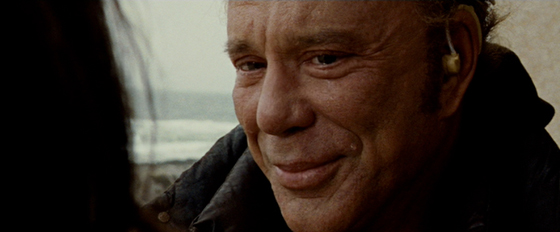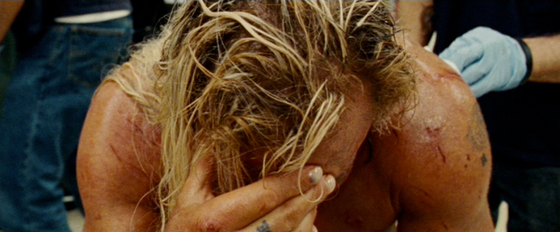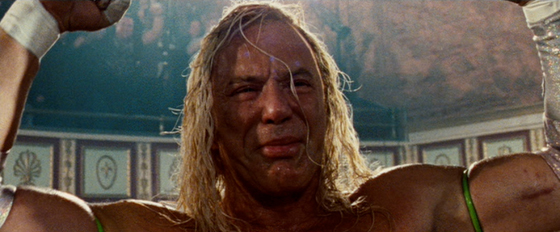The Wrestler Screenplay Analysis
I’m excited to offer a partial Story Map for the 2008 drama, The Wrestler, written by Robert Siegel and directed by Darren Aronofsky. The full story map for The Wrestler is available in my book Story Maps: How to Write a GREAT Screenplay. (Please note that the maps in the book are text-only; they do not contain images like some of the sample maps on my site.)
The Wrestler‘s running time is 105 minutes, which is closer to my suggested length of 110 pages that my Story Map paradigm is built on. Actually, anything in the 100-110 pages zone is gold, in my opinion, and this comes from working as a professional Story Analyst and experiencing the horror of being handed a 144 page script, for which I would be paid the same paltry amount as a 99 pager. Yikes.
Anyway, to your benefit, I’ve been mapping mostly longer films thus far on this blog, so I really wanted to post a film that is faster paced.
Some things to notice in The Wrestler screenplay Story Map:
- The Inciting Incident happens at page 5, rather than the normal 8 – 10 range. To this I say hey, the sooner the better! If you can get us into the action faster, go for it. What you do not want to do is slow it down — an Inciting Incident on page 15 is a very bad idea. You should also note that this is a “soft” Inciting Incident in that it’s an escalation of the previous scene. We already know Randy is down on his luck because he was wrestling in a school gym and the fight promoter handed him only a few bucks, telling him that attendance was down. So when he comes home to find himself locked out of his trailer because he hasn’t paid his rent, it’s not a big shocker. He’s not finding a dead body or finding out he has a kid he didn’t know about. But it’s still the Inciting Incident because it shows that his failures as a wrestler have now affected his home, his personal life. This type of soft Inciting Incident is easier to pull off in an indie Drama — a high-concept Hollywood movie would call for an event with more punch factor.
- There is a very clear delineation between External and Internal lines of action, built on the classic “work and love” model. External: Become a wrestling champion. Internal: Get the girl. In this case, it’s girls, as he’s trying to win over Cassidy, his new potential girlfriend and Stephanie, his estranged daughter. But Cassidy is more important to the story, thus she is introduced earlier, given more screen time and she is present in the end for Randy’s climactic decision to choose the wrestling ring over love.
- I’ve put the official Midpoint at page 60, the one hour mark, which is a common device in films, but as a Reader I always start looking for it around page 50 because it works best when it’s dead center in your screenplay. So a 100 page screenplay should have a Midpoint on or around page 50; a 110 pager, on or around page 55. I’m anxious if I have to wait until page 60, but I recognize the importance of the 60 minute mark since audiences are conditioned to expect 30 minute chapters. But 60 is the cut-off! Especially in a 110 page script because then your two halves will not be balanced and that’s no fun for anyone. No, it’s not the end of the world, but again: when a Reader’s job is to read hundreds of scripts they are conditioned to recognize and look for patterns, one of which is that you don’t put your Midpoint past page 60.
- Speaking of Midpoint, you’ll notice that there IS a worthy beat in The Wrestler at 55. This is the moment at which Cassidy gives Randy the advice to go to his daughter, which is the first true step in their romantic relationship and it sets him on the path toward redemption with both women, which he won’t achieve as this is a tragedy. So the ultimate point is, I could have been a smug bastard and put the Midpoint at 55 as it is in my ultra-official Story Map beat sheet but I chose to show more respect to the filmmakers. (This is the point in the article where you realize it’s not so much about The Wrestler as it is about me. But I digress. And I kid, but only because this fine movie is such a freakin’ downer in how it crushed my dream of someday being an HGH-fueled WWE star. Then I would beat up Mr. T. But enough about my fantasy life.)
- The film ends on an ambiguous note, with Randy flying through the air in mid-Ram Jam (Which I imagine might be the funnest part of a Ram Jam. At that point, everything’s possible, ya know?). Aronofsky has said that he feels Randy definitely dies in the ring after the film ends. I like the ambiguity as it doesn’t matter if he wins the fight, loses or even dies, he has made the wrong choice and his soul will never be saved. This works because his arc is complete.
- I must admit that Theme is a tough one in this story. I ultimately settled on “Pride goeth before the fall,” but there’s such a strong connection to the past in almost every scene that wonder if it’s closer to “You can’t reclaim the past” or perhaps more accurately, yet less eloquently put, “There’s no do-overs in life.” What do you think, gentle reader?
- Theme is a great device to “control” dialogue, as we see in many of the key lines in the film that reference the past: “I’m just an old broken down piece of meat and I deserve to be all alone.” “90s sucked.” “Two words: Re. Match.” “The only ones that are gonna tell me when I’m through doing my thing are you people here.”
I encourage you to watch the film and study The Wrestler Story Map and post your thoughts below or via email to me.
Enjoy THE WRESTLER STORY MAP.
Here’s the beautiful trailer:
Again, special thanks to the fantabulous Story Mapping skills of Dustin Tanner and good luck to him on getting his musical drama screenplay set up.





I did have a question re: your “Big Idea” page, but there wasn’t any place to leave a comment there so hopefully this will suffice.
From your perspective and background, should one be revealing any big twist right up front? I noticed you had written this “The Others – A family plagued by a haunted house turn out to be the ghosts haunting the real family that lives in the house.”
Is it better to reveal that as a marketing hook, even though it’s giving away the ending and really not the hook “into” the story itself? On one hand, I can see saying, yes, you want to give prospective readers your “A” game… but doesn’t that take away from the actual experience of discovering it?
I have a feeling your answer will be along the lines of “it’s never going to have that chance to be discovered if it’s not read, so you got to do what it takes to get the script the attention the twist might deserve”.
Thanks!
MPS
“I have a feeling your answer will be along the lines of “it’s never going to have that chance to be discovered if it’s not read, so you got to do what it takes to get the script the attention the twist might deserve”. ”
You got it! But…it’s a bit more complicated than that and depends on the script and the situation.
Firstly, from my experience, the Reader who reads your submission and writes the coverage doesn’t usually know the logline or see the accompanying cover letter; they go in cold. (This may depend on the company, though.) Secondly, it’s always difficult to get your script accepted for submission, especially if you’re unrepped, so if your concept doesn’t have that zing without giving away your BIG ENDING or that BRILLIANT TWIST, then you should include it in your logline and your 10-second phone pitch, IMHO. Because you’re not blowing the movie for the AUDIENCE, just for this particular executive or assistant who has 50 other writers asking for him/her to read their scripts that week, so you need to bring the big guns if they’re going to have any interest in reading your script.
With that said, if you have a high-concept Big Idea that survives on its own without giving away the twist down the line, then don’t give it away. Stick to your core premise. I think The Others is an example of not needing to give away the final twist that they are the ghosts. If you were submitting a logline for it, it would be enough to say “A war widow on the Channel Islands in [1944], alone in a dark mansion with her two young children who are hyper-sensitive to light, must protect them from ghosts.” That sounds very interesting to me and I’d want to read it (although it’s not the best logline, of course, just off the top of my head).
My $0.02. Good Luck and Happy Writing!
I don’t see this film as a tragedy because I don’t view Ram’s choice as the wrong choice. Perhaps it’s a matter of perspective, but what Ram does in the final scene IS reclaiming his past. Considering Ram has been stripped of wrestling due to his heart condition and that ultimately, it’s the only thing he has to fall back on -- the girlfriend left, that was her decision -- he chooses to go out in a blaze of glory with the audience’s adulation.
That’s the one thing he couldn’t get through any “real” relationships he pursued. Despite how it may look objectively, we HAVE to consider whether this is a failure/success or positive/negative THROUGH the main character’s POV. In this case, it’s a success. He’s doing what he didn’t think he would ever do again; the ONLY thing he can do. And he goes out to the roar of the crowd. How is that a tragedy if we’re viewing the story through his eyes? Are you saying it would be better if he simply faded away in a trailer?
The same can also be said of Black Swan. The main character there achieves her goal, despite the costs. A tragedy occurs when somebody pursues their goals and doesn’t achieve them, nor do they change as a result.
Interesting point, Marcus, but one can’t deny that he could have forged a new, happy life with this woman that loved him (Marisa Tomei) and continued to make inroads with his daughter if he really tried harder.
“Reclaiming his past” is the tragic move because his past is exactly what got him into the dire straits that he was in. He refused to accept that his fame was fleeting and the pursuit of glory was not a long-term investment, thus he ended up penniless in a van, alone. I don’t see it as going out on his terms as much as it is not being able to kick his “drug,” which is the adulation of the crowd. And that drug is what ruined his life and ultimately, kills him. (Aronofsky has said that he definitely feels that Randy dies after the jump, but since it’s not shown, it’s still up to your interpretation)
My two cents. Great films are always challenging and can be interpreted in different ways and that’s one of the aspects we love about them. E.g., my interpretation of the ending of Raiders of the Lost Ark has stirred up debate on multiple occasions, and that’s okay with me.
Thanks for the thoughts. 🙂
And the e-book version of Story Maps: How to Write the GREAT Screenplay is available now with a consultation for a limited time HERE.
I’m gunning for the book to be published by January 1st, but I’m working on a writing assignment while doing lots of script notes so I’m a busy man — it’s getting tight! I’ll keep you all posted and I apologize for the delay. 🙂
This is one of my favorite films. Reminds me in many ways of the original Rocky film. The protagonist is down on his luck and gets an opportunity to turn it all around. The Wrestler takes a darker turn, but feels like the same film in many ways. My question to you is in regards to the inciting incident. Isn’t The Wrestler like Rocky, where the inciting incident is the getting the opportunity for the big rematch/fight? And when will your book be complete? I’ve downloaded all of your story maps and can’t wait to get my hands on some more.
Hi Jeff,
No, I’m defining the Inciting Incident as the event of high conflict in the page 8-12 range (10 being the sweet spot, IMHO) that throws the initial, established “order” of this dramatic world into chaos and invariably launches the Protagonist on the path toward the pursuit of their major goal/s. But the Protag is usually not ready yet to enter this doorway.
In the case of The Wrestler, the idea of a big “Rematch” bout doesn’t get introduced until minute 17, which is firmly in the range of what I call “Strong Movement Forward,” which is the Protagonist’s first STEP onto that inevitable journey. Notice that Randy says YES to the offer of the rematch (“Bring it.”), thus he’s now moving toward it. They could have moved this up to minute 10 to get the story moving that much faster, but they had crucial character content to show us that establishes his dramatic NEED for the rematch.
In the case of ROCKY, he doesn’t actually accept the fight offer until the Midpoint, halfway through the story. This works because the story is more about Rocky finding self-esteem and love than it is about training for one fight. I’m posting my Rocky Story Map soon!
Both great films that we can learn a lot from, so study their structure and watch them again. Good luck and Happy Writing.